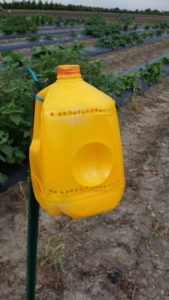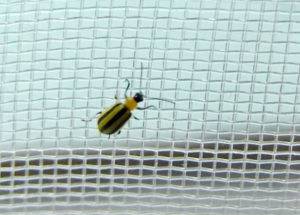One of the most problematic insect pests that organic vegetable growers have to deal with is the striped cucumber beetle. The insect feeds on all the cucurbit crops, but can be particularly devastating to muskmelons and cucumbers because those two crops are susceptible to bacterial wilt of cucurbits, which is caused by a bacterium carried by the beetles. The only way to avoid this devastating disease is to prevent the beetles from feeding on the plants. There are no effective organic insecticides for managing striped cucumber so we have to look for alternative methods.
- Row Covers: Row covers can be used to physically prevent beetles from feeding on the plants. To be effective, these need to be placed over the plants immediately after transplanting or before direct seeded crops emerge. The edges of the row covers should be sealed with soil to prevent the beetles from crawling under the fabric and attacking the plants. One downside of row covers is that they must be removed or at least opened up on the ends when female flowers appear so that pollination can occur. This action, of course, also exposes plants to feeding from cucumber beetles. Row covers are also fairly expensive and practical only on fairly small plantings. Row covers will also protect plants from seedcorn maggots, so growers may want to use this technique on very early plantings.
- Trap Crops: Various types of squash are more attractive to striped cucumber beetles than cucumbers or muskmelons. Since the squash are not susceptible to bacterial wilt, they can tolerate a lot more feeding damage than the vulnerable crops. Planting squash a little earlier than your nearby cucumbers and muskmelons will often result in more beetles on the squash and fewer beetles on the susceptible crops. It is important to recognize that once the trap crop declines, the beetles will be searching for a new host.
- Beetle Traps: Recently, Dr. Jaime Pinero from Lincoln University in Missouri, developed traps that can be used to trap out most of the striped cucumber beetles from a small farm. The instructions for how to construct and use these traps can be found at https://ipm.missouri.edu/IPCM/2016/6/A-novel-mass-trapping-system-to-control-cucumber-beetles-in-cucurbit-crops/. These traps are homemade with the basic unit being 1 gallon milk jugs (Figure 1), so it might be a good idea to start working on these now. The attractant and the stun pill must be purchased. An alternative to the stun pill may simply be drowning the captured insects by filling the base of the jugs with water and some soap to break the surface tension. We will be testing these traps at several sites this summer and will report the levels of control we receive in future Vegetable Crops Hotline articles.
- Exclusion Screens: For those growing in high tunnels, it can be effective to install insect exclusion screens to prevent cucumber beetles from damaging the crops (Figure 2). If growing parthenocarpic varieties you do not need to worry about pollinators. However, if a pollinator-dependent crop is produced bumblebees can be purchased from commercial supplies and perform well in high tunnels as well as greenhouses. Care should be taken when selecting a mesh screen, our research has shown that a pore size of approximately 0.8 x 1.0 mm is sufficient to exclude the beetles while minimizing the reductions in ventilation (Figure 3). Secondary pest outbreaks, such as aphids, have occurred more often when screening was applied to high tunnels. Careful scouting plans should be in place to monitor for aphids and mites in these situations.
While there are also a variety of natural enemies in these systems that attack cucumber beetles, the economic threshold of 1 beetle per plant for the crops susceptible to bacterial wilt limits the feasibility of this control method. These natural enemies include spiders, ground beetles, nematodes that attack the larvae and pupae in the soil, and parasitic flies. Combinations of the techniques described above, such as combining trap cropping with the beetle jug traps, may be the most effective organic strategies for controlling this devastating pest and pathogen.


